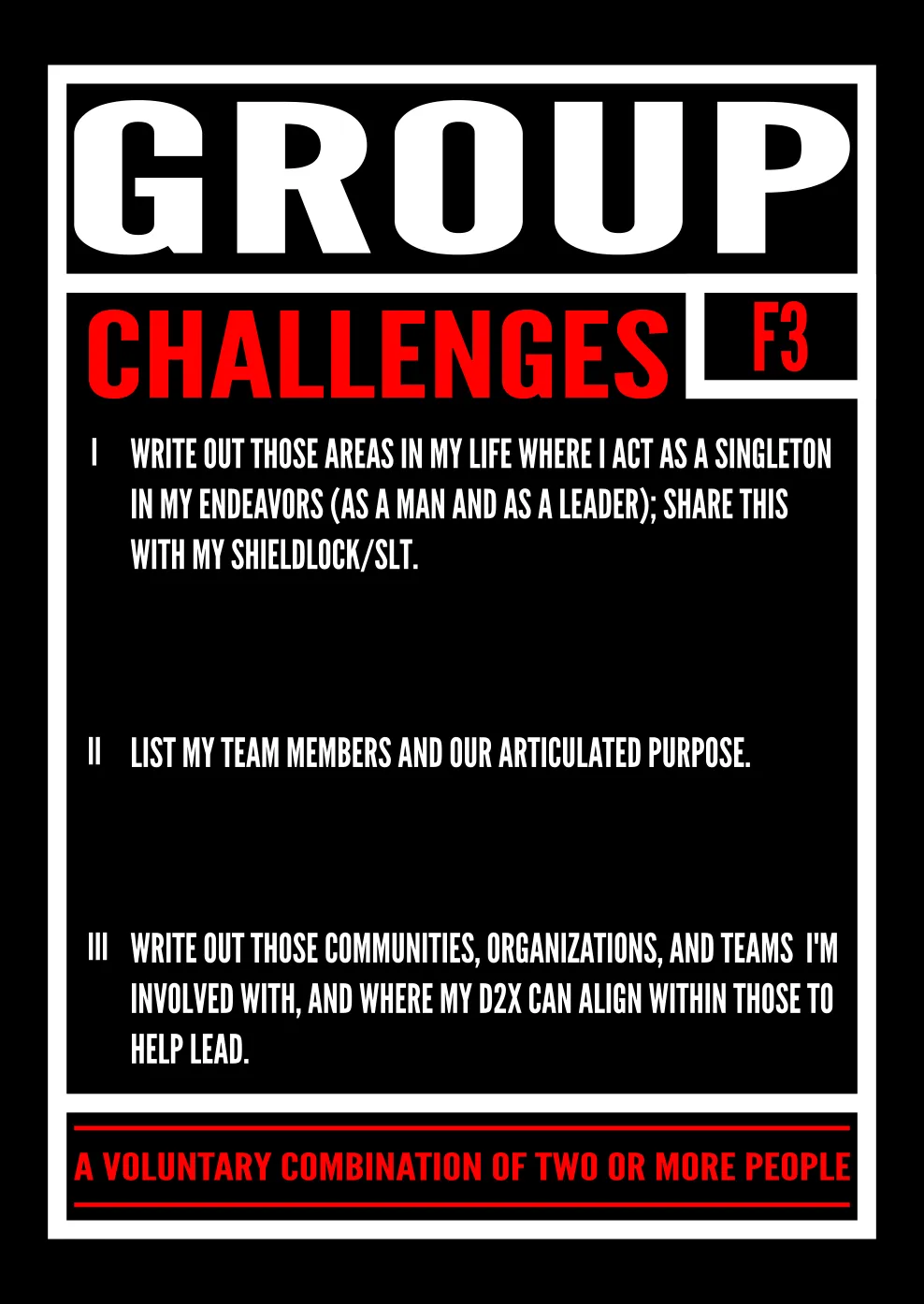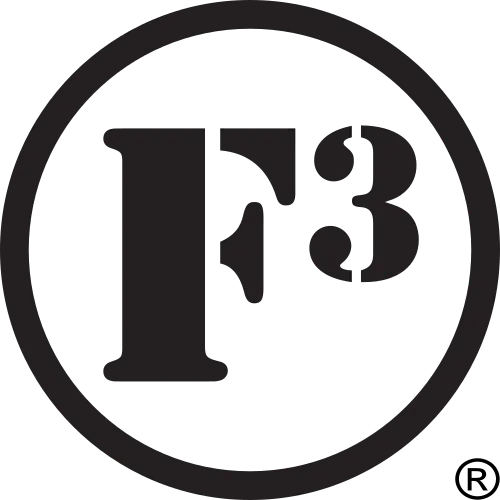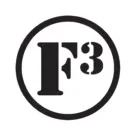GROUP (F3)
A Voluntary Combination Of Two Or More People
Man is by nature a Group-forming animal
A Group is a voluntary combination of two or more people. There are three distinct types of Groups that are relevant to the QSource: communities, organizations and teams.
The specific reasons that lead people to combine and the manner in which they come together are both immaterial to this very broad definition. Nor are there any formational requirements to meet the definition of a Group beyond a tacit agreement between the members to voluntarily combine. Group membership is never coercive.
Some Group-types (like a corporation or county government) have complex formational requirements and structural barriers that make entry and departure more difficult, but that does not make them any more Group-ish than two men who simply start meeting for coffee every two weeks to talk about whatever is on their mind. Two or more people + voluntary combination–that’s all that is required to meet the definition of a Group.
We seek strength in numbers for a variety of different reasons, but the most elemental is that life itself, while technically possible as a singleton, is not practical without combination with others. Loneliness is our subconscious yelling at us to go find a partner because we are not supposed to live like that. It’s dangerous.
An illustration of this elemental need to combine is portrayed in the movie Castaway. Tom Hanks plays Chuck Noland, a man shipwrecked alone on an island in the middle of the Pacific. Initially he is consumed with learning the basic survival skills for which modern man has no direct need (like starting a fire or spearing a fish in shallow water) but which make the difference between life and death for a modern man cast out into the wilderness alone. After many failures, Chuck is triumphant at the ignition of his first fire. Dancing around the flames, he does not for the moment hear the voice of loneliness yelling at him.
But, flashing forward four years (after a self-administered root canal with a hockey skate almost kills him) we are presented with a different man. Lean and competent at survival, Chuck spears a fish with one quick flick of his wrist. But now there is no dancing. The camera focuses in on a face consumed by worry illustrating how Chuck has been worn down by loneliness. In fact, we come to find out that he has been experimenting with means of suicide because he knows he is only one unlucky fall away from dying slowly and painfully from a broken leg. Life alone is dangerous, too dangerous to be worth the risk.
We learn of this realization from Chuck’s “conversations” with a volleyball upon which he has finger-painted a face. So deep is his need to be part of a Group, that Chuck creates a co-member in his mind with whom to combine, who he calls Wilson. The Group (Chuck and Wilson) decides that the risk of death on the deep blue sea on a rickety raft is worth the slim possibility of finding other people. The ocean is dangerous, but not nearly as dangerous as life alone on the island.
Chuck’s willingness to push his boat out into the surf and abandon the safety of his island dramatically depicts the human drive to leave a condition of temporary security in search of a more advantageous position. Group membership provides Advantage: a superior condition achieved by Movement . Just as Chuck had to move from the island to find civilization, a lonely man must move outside of himself toward another man to form a coffee-Group. Reasonable minds can debate which type of Movement is more difficult.
Man is hard-wired to seek the Advantage incumbent in Group membership. Different Group-types provide different Advantages. A book Club provides fellowship for literature enthusiasts. Reading is a solitary endeavor but literature can be enjoyed in combination to mutual Advantage. The provision of legal services only requires a single law license, but lawyers combine into law firms for the Advantage provided by association with other practitioners. Although they are vastly different, a book Club and a law firm are both Groups that provide Advantage for their members.
F3 being a leadership Group, we are primarily concerned with the composition of Groups from the perspective of how they are best led. All Groups (whether they have two or two-million members) must have a leader. And, that leadership (specifically, how it is best exercised) varies with respect to the Group-type being led. Thus, while both book Clubs and law firms must have leaders, the manner in which they are most successfully led is not the same at all.
The three Group-types that must be led to Advantage are the community, the organization and the team
COMMUNITIES
The first Group-type is the Community, which is two or more people that voluntarily live in close Proximity . A Community is defined by the geographical Proximity of its Members , not by immutable characteristics such as skin color or gender.
Communities are concentric. A family is a Community whose Members live in the same house and in the closest possible Proximity. A neighborhood is a Community of families in which the Members live in relatively close Proximity. A cluster of neighborhoods form a town, which is a Community with Members living in more distant Proximity. A collection of towns form a county, which is a more distal Community–as is a state, the nation and ultimately the world.
Leaders have the most impact upon the Communities that are at the center of their Proximity circle. Thus, a father is much more important to his family than is the governor of the state or the president of the nation. The governor and president are important, but they are less Proximate. The father is more Proximate.
The Governor of North Carolina is very important to his own family and less so to mine because I live two hundred miles away from the capital. Although we are both white middle-aged male lawyers (as I write this), I’ve never met the man and neither have my children. Our lack of Proximity means that we are not in Community, despite the characteristics that we share.
Ultimately, the Advantage provided by all Communities is the same, to respond to the human need of its Members to dwell in Proximity to other people for their mutual Advantage. We form Communities because we are naturally driven to do so. If human nature were otherwise, we would all be hermits. Chuck would have happily lived out his life on the island spearing fish and discoursing with Wilson instead of risking his life to find Proximity with another human.
The requirements of Community Membership are largely passive. The implicit agreement that forms a Community arises from where the Members live, not what they do there. As a result, little is required of a Community Member other than to generally abide by its laws and mores so that the Group’s peace and harmony can be maintained. A healthy Community is one in which its Members have as much safety as they believe they need and the opportunity to be as significant as they believe they want to be.
ORGANIZATIONS
The second Group-type is the Organization. An Organization is two or more people that voluntarily combine for the accomplishment of an articulated purpose. Unlike Communities, the Members of an Organization are defined by their shared mission not their Proximity. Thus, they need not all (and generally do not) live or work together.
There is some obvious overlap between a Community and an Organization. For example, the residents of Idaho constitute a Community, while the employees of the governing apparatus of the State of Idaho are Members of an Organization. Idaho-the-Community and Idaho-the-Organization have some crossover. The governor of Idaho is by definition a leader in Idaho-the-Organization, but he is also a leader in Idaho-the-Community if he has impact on its Members, but then only concentrically, starting with his own family and moving outward.
While this Community/Organization crossover exists, it is limited. A leader must keep clear the distinction between the two types of Groups because they are completely different organisms. Communities do not need organizing (they exist only to be, not to do) and Organizations do not need community (they exist only to do, not to be ). Thus, it is illogical to call a man a “Community Organizer”. No such thing can exist and would be unnecessary if it did. What does exist (and what is sorely necessary in both Communities and Organizations) are virtuous leaders.
While the health of a Community can be assessed by the degree of peace and harmony in which its Members dwell together, Organizations are defined by the Effectiveness with which they accomplish their Mission. Viewed through the lens of Effectiveness, there are three types of Organizations: Lizards, Bullfrogs and Leeches.
A Lizard is an Organization that is dedicated to the Effective achievement of its Mission. In fact, a Lizard’s leaders do not believe that their Organization exists for any reason other than to realize its purpose. Whereas an Organization that is dedicated to maintaining something that has been previously achieved is an institution, the Lizard is forward-looking. It seeks change through Movement. Its leaders are Disruptive. A Lizard is by definition a movement rather than an institution. Because leaders are critical to a movement, Lizards must have a vibrant leadership development process. Within the universe of Organizations there are very few Lizards.
The majority of Organizations are Bullfrogs. Unlike a Lizard, a Bullfrog is an institution with the primary goal of the continuity of its own existence. Maintaining what was previously accomplished requires managers, not leaders. Bullfrogs, immobile institutions that they are, do not need Disruptive leadership because they are not going anywhere. The only challenge tomorrow may bring to a Bullfrog is the maintenance of the slow-motion dance required for it to stay firmly planted on yesterday’s lily-pad.
Because it is governed by managers rather than leaders, creates nothing and expends its resources on existential continuity, the Bullfrog is continually in danger of morphing into the third type of Organization, the Leech. A Leech looks less like an Organization than an enervated mob that only survives by feeding off of Bullfrogs too overcome by their own lethargy to shake them off. Within the dispirited ranks of a Leech it is every man for himself because individual continuity ultimately trumps Organizational continuity. A Leech has neither managers nor leaders, only survivors. It is a failed and purposeless institution that is crumbling from within.
All Organizations exist on a normal curve of Effectiveness that extends from Lizards on the last deviation on the left to Leeches on the far right. In the middle, representing the mean, reside the Bullfrogs that comprise the majority of all Organizations. This Organizational Effectiveness curve only provides a snapshot of current conditions, because Organizations (like their Members) are dynamic not static. They are constantly changing in ways so small that they may be hard to see, but that nonetheless cause them to move along the continuum.
Ultimately, and unfortunately, Organizational movement is almost wholly rightward–towards Leechdom. Thus, an Organization that was a Lizard yesterday becomes a Bullfrog today and may tomorrow be a Leech, unless someone intercedes to Disruptively influence Movement to Advantage.
TEAMS
The final Group-type is the Team, which is two or more people who combine to perform a specific mission for the benefit of a Community, an Organization or both. Teams may be formed at the direction of the Governance of a Community or Organization, but they more often arise organically under the leadership of a Member who identifies a Problem and sets out to solve it.
The primary difference between a Team and an Organization is that Team Members are in close Proximity while Organization Members may never even meet. The primary difference between a Team and a Community is purposefulness–a Team exists to do something while the Community exists to be something.
Because the Proximity between Team Members is not for the purpose of peace and harmony but to to achieve Advantage, Team Membership is defined by active contribution made to the Team’s Effectiveness not passive conformance to its rules and mores. Unlike the Member of a Community, the Member of a Team must do something rather than just be something to enjoy good standing.
While Communities and Organizations can thrive regardless of their size, a Team must be big enough to accomplish the Mission yet small enough that its teamwork is vibrant and uninhibited. It is within Teams that people have the most opportunity to lead. Thus, Teams are necessary to the leadership development process of any Group.
Dynamic Teams are the heart of healthy Communities and Effective Organizations
At its most Effective, a Lizard is little more than a network of Teams that work efficiently together to solve the Organization’s Problems and advance its articulated purpose. Similarly, a healthy Community is embedded with Teams that form to serve and enhance the peace and harmony of its Members. Ultimately, dynamic Teams are the product of strong Community and Organizational leadership, which encourages their formation and rewards their efforts through well-aligned incentives.
Whether a leader is concerned with the health of his Community, the Effectiveness of his Organization or the dynamism of his Teams (or all three), the QSource provides a framework for him to more skillfully influence Movement to Advantage – which is the heart of leadership.
updated: 2025.03.10

Additional Study Materials
Socratic
Is man’s natural desire solitude or combination?
Are there different types of groups that people form?
Are there any types of groups that are more important than others?
Spur
Man is by nature a Group-forming animal
The three Group-types which must be led to Advantage are the Community, the Organization and the Team
Dynamic Teams are the heart of healthy Communities and Effective Organizations
Additional Resources




Facebook
Instagram
X
LinkedIn